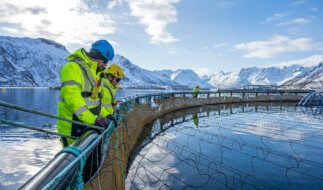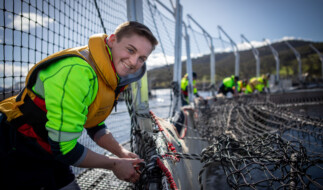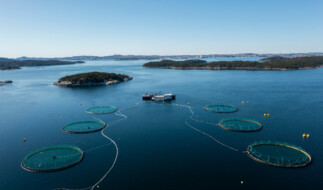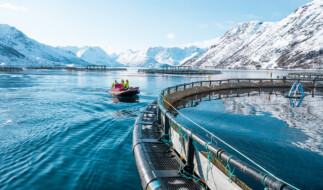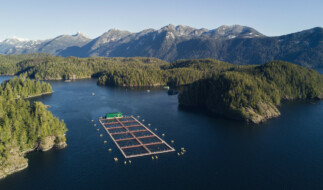As responsible salmon farmers we are taking a proactive approach to understanding possible ESG risks in our operations and supply chains so that we can make adaptations to improve the long-term outlook for our businesses and sector.
What is ESG?
ESG is the set of three pillars that companies are most commonly expected to report on to evaluate their sustainability and ethical impact. The goal of ESG is to capture all the non-financial risks and opportunities related to a company's daily activities.
- E – environmental criteria: energy, water, resource use.
- S – social criteria: social criteria: animal welfare, labor relations, diversity, inclusion.
- G – governance: internal practices, controls, and procedures that guide a business.
Why is ESG so important?
An ESG framework enables businesses to connect a series of factors, including the environmental, social, and governance pillars. This approach provides a more holistic overview of a company's footprint and contributions, and helps determine the extent to manage these factors, improve on them, and report on them transparently. Stakeholders from different groups are all requiring more information from companies, whether it is consumers wanting to make sustainable choices, regulators interested in solving problems from pollution to diversity, or investors looking to make smart investments. ESG reporting can provide the information needed to meet these requests.
Salmon farming and ESG
We recognize there are potential risks in our supply chains which we have a responsibility to act on.
Our feed supply chain is one critical area. Animal protein production, whether salmon or other animals, all require feeds made up of a multitude of complex ingredients. These ingredients have a range of possible impacts from their supply chains, including GHG emissions, water use, land conversion, or use of natural resources such as wild fisheries. And while buyers of animal feed have significant information on the nutritional information of these ingredients, it is currently more challenging to know all the details on where the ingredients originated, how they were sourced, produced, and manufactured. This must change now to ensure a more sustainable and resilient future for the sector.
ESG Feed Risk Assessment Tool
Since 2022, GSI has been working with World Wildlife Fund (WWF) to develop an ESG Feed Risk Assessment Tool. This tool helps salmon farmers and their feed partners conduct holistic ESG assessments across the feed supply chain to better understand the risks and make more informed decisions on the ingredients they choose. Additionally, the tool is meant to aid in informing which novel ingredients are the most promising to test and which are market ready, ultimately leading to more sustainable supply chains in the future.
The topics included in the tool were deemed to be most material to accomplish the goals of understanding traceability and transparency in the supply chain. They include:
- Transparency
- Management systems
- Governance
- Basic human rights
- Restorative land use and biodiversity practices
- Fisheries
- Carbon footprint
- Circularity
- Pollution
- Water consumption
- Fish health and nutrition
- Human health and nutrition
- Climate change impacts
- Scalability
For more information on the tool and what’s covered, take a read of this feature in World Aquaculture Society magazine.
The surprising amount of unknown information in feed-ingredient supply chains leaves the sector open to unintentional risks and vulnerabilities—even for companies prioritizing sustainable, ethical production. With this tool, GSI members are taking a proactive approach to address these risks and identify opportunities to improve the supply chain. Looking at supply chains broadly and holistically doesn’t just mitigate risk; it also facilitates more informed and strategic decisions.Daniel Miller, aquaculture lead specialist at WWF.
What's important to know about the tool?
- 2024 marks the first iteration of the tool. We anticipate evolutions of the tool in future years as we gain greater insights into supply chains and how the tool works.
- Given the competitive nature of the data requested, the tool is exclusively used between the farming company and the feed supplier, and no data is shared outside of this.
- By GSI companies working together to support the development of the tool, the intention is to standardize the requests made to feed companies to help streamline their efforts and provide consistent comparisons across ingredients and risk profiles.
- GSI has also worked with partners to align the tool to common industry standards: Best Aquaculture Practices (BAP) and Aquaculture Stewardship Council (ASC). ASC has also confirmed their intent to use the tool as part of their due diligence process for their Feed Standard certification.
- While GSI and WWF have worked closely to co-develop the tool, the applicability and scalability of the tool has the potential to extend beyond the farmed salmon sector to across all sectors requiring feed. We welcome other organizations and sectors to reach out if interested in trialing the tool.
Download the GSI ESG Feed Risk Assessment Tool
Download the toolAccelerating industry-wide change
Our ESG Tool can enable companies to identify possible risks in their supply chains proactively rather than reactively, and make it easier for companies to focus on improvement strategies to meet evolving ESG requirements.
By committing to use the tool in dialogue with their feed suppliers, GSI member companies aim to drive greater traceability and transparency across the supply chain. This collaborative approach will deliver quicker and more significant results than if each company were working alone.
If you are interested in learning more about our ESG Feed Risk Assessment Tool, please reach us through our contact page.
